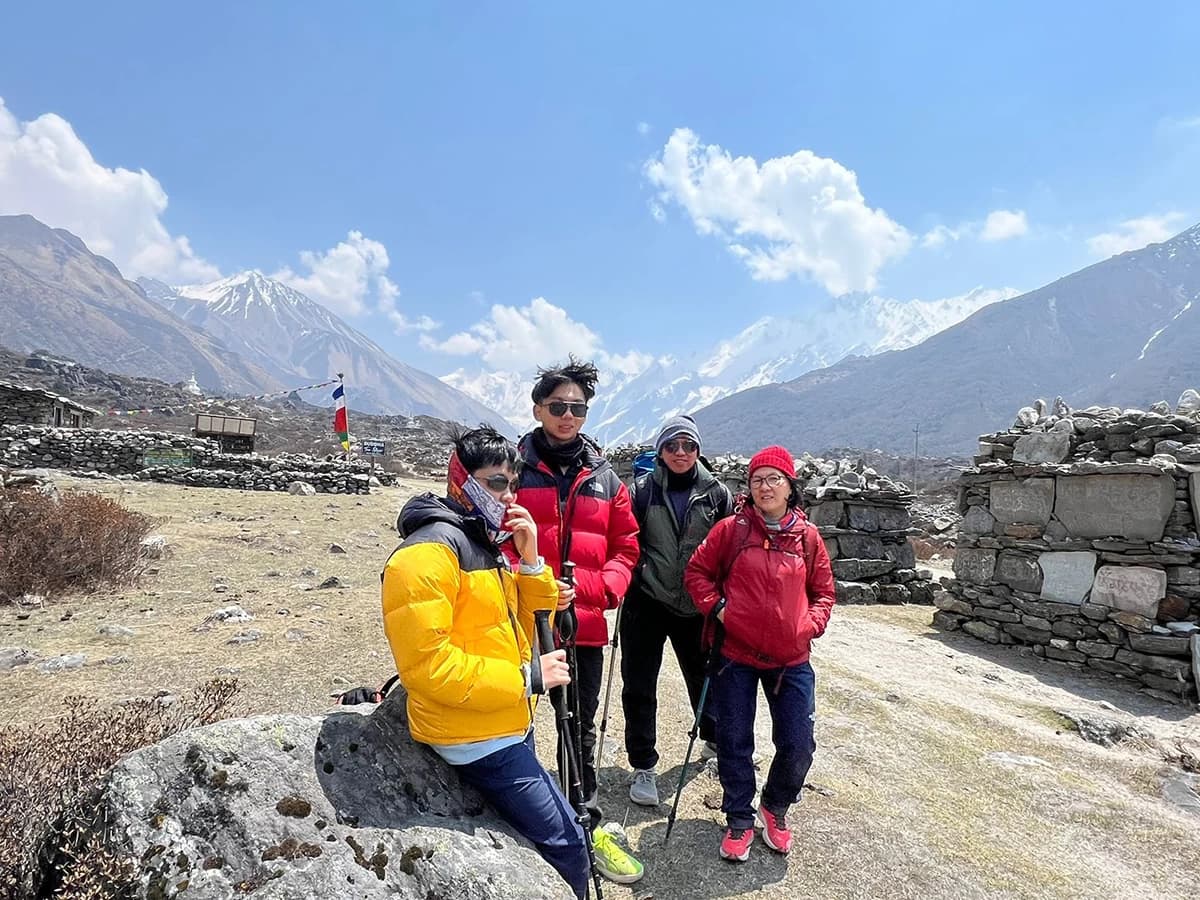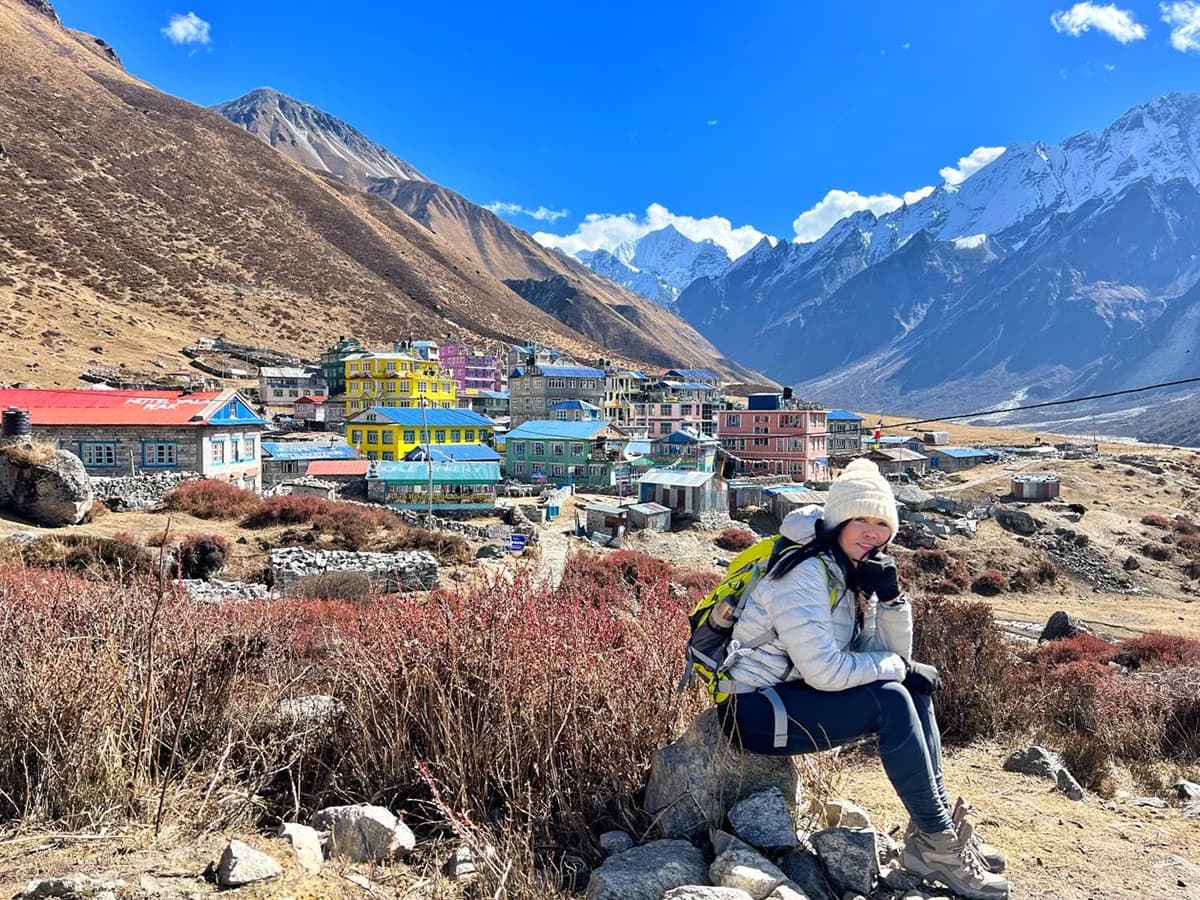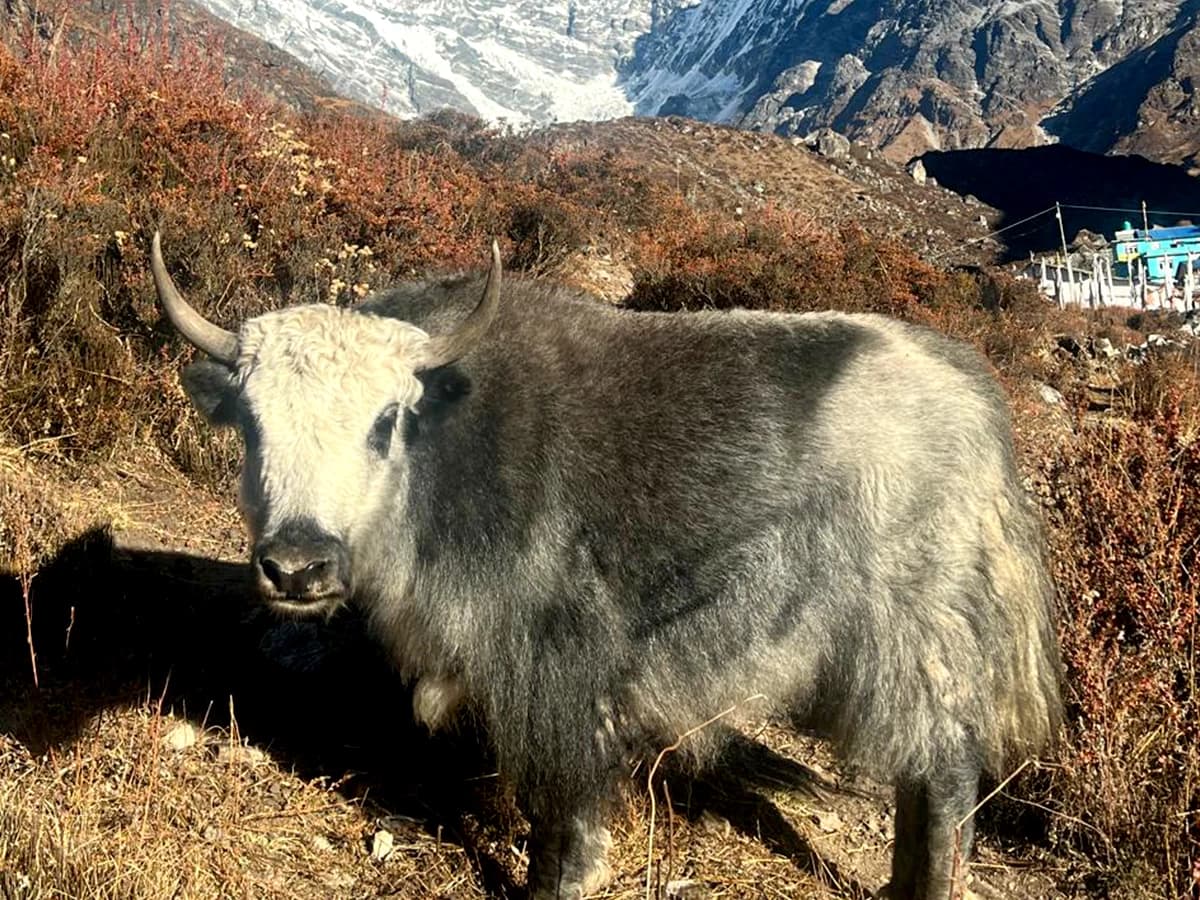"Away from the bustle of the modern world and the chaos of big cities, the Langtang Valley trek 10 days presents a fantastic retreat. You will be in nature surrounded by tall mountains, soothing scents of Earth, tranquility, and warm hospitality of locals. The trek will push you out of your daily routine, give you a break from the digital world, and test your endurance. You are bound to grow, rejuvenate, and reconnect with yourself on this adventurous trek in the Himalayas!"
The Langtang Valley trek is a short and sweet adventure in Nepal that you can complete in just 10 days. From Kathmandu, the trekking route is easily accessible with 7 to 8 hours of drive. You will start and end the trek at Syabrubesi.
You will spend six days trekking, and the remaining three days will be spent traveling in and out of Nepal and driving between Kathmandu and Syabrubesi. Kyanjin Gompa is the highest village in the Langtang Valley. Before reaching Kyanjin Gompa, you will also spend nights in the Lama Hotel and Langtang Village.
Likewise, Tserko Ri, a viewpoint, is the highest point you will reach on this trek. The proximity of the Langtang region from Kathmandu and its unparalleled natural and cultural richness has made it a top trekking destination in Nepal.
Among all the treks in the Langtang region, the Langtang Valley trek is most loved by trekkers. The trekking route runs through the lush forests of rhododendrons and bamboo alongside the beautiful Langtang River and cascading waterfalls.
The trail is within the Langtang National Park, so you may stumble upon exotic flora and fauna. Likewise, the locals are kind, humble, and welcoming. You will feel at home away from your home. To make the journey more exciting, breathtaking mountain vistas and stunning scenery will accompany you throughout the voyage.
Why is the Langtang Valley trek a great alternative to Everest & Annapurna?
Most foreigners planning to trek in Nepal know about treks in the Everest and Annapurna regions. These two are the most famous and commercialized trekking destinations in Nepal.
Compared to these two trekking areas, Langtang is less crowded, less commercialized, affordable, easily accessible from Kathmandu, and involves short trekking duration and distance.
The Langtang Valley trek is a great option if you are looking for a quick trip in the Himalayas. You do not necessarily need 6 to 8 weeks of preparation time or a big budget for this trek.
While the Langtang Valley trek perks are quite good, the adventure and the landscapes are also incredible. You will experience the standard 6 hours of walking days, lovely mountain villages, rugged Himalayan terrain, high altitude, and moderate trail difficulty level.
Therefore, you are not missing out on anything by doing the Langtang Valley trekking. Moreover, this trek will build your confidence and prepare you for more challenging treks like Everest Base Camp and Annapurna Base Camp.
Trekkers looking for the best short trek in Nepal should go for the Langtang Valley trek 9-day!
Key highlights of the Langtang Valley trek
Below, we have shared the key highlights of the Langtang Valley trek, but do remember that the trek has more to it:
Panoramic views of Langtang Lirung (7,227m)
Langtang Lirung stands 7,227 meters above sea level. It is one of the most beautiful mountains in Nepal. The Langtang Valley trek offers the closest views of this iconic mountain. Many parts of the trail offer outstanding views of this mountain, but our favorite is the view from Kyanjin Gompa and Tserko Ri.
Explore Langtang Village (post-earthquake revival)
The tragic earthquake of 2015 left Langtang Village lifeless. Everything was destroyed, and the villagers suffered huge losses. However, as time passed, the village once again began to revive.
Today, Langtang Village is back to its beauty and stronger than ever. You will spend a night there. The locals and their stories will make your stay incredible. The village is small, but you will have a great time here.
Visit Kyanjin Gompa (a Buddhist monastery)
Kyanjin Gompa is located 3,870 meters (12,697 ft) above sea level. It is the most important religious site in the Langtang Valley for the locals. Apart from the monastery, Kyajin Gomps is also the name of the settlement surrounding it.
The monastery is very old and features colorful murals, prayer flags, prayer wheels, and monks. For trekkers, Kyanjin Gompa adds cultural richness to their journey.
The Tserko Ri Viewpoint
Tserko Ri is the highest point you will reach during the Langtang trek. It is a viewpoint that you can reach in around two hours of hiking from Kyanjin Gompa. The route is offbeat and steep, so you have to be very careful while ascending and descending.
You will hike to Tserko Ri early in the morning to see a beautiful sunrise and a panoramic view of the mountains. From here, you can also see other mountains like Langtang Lirung, Yala Peak, Langshisha Ri, and Gangchenpo, along with Langtang Glacier and Kyanjin Village.
The hidden Hydro Glacier Lake
You may not have read about Hydro Glacier Lake anywhere else. It is a hidden lake located near Kyanjin Gompa that you can reach in half an hour of hiking. Leaving Kyanjing Gompa, follow the trail to the cheese factory. You will see a gompa and two trails.
Follow the left route from the gompa and walk for a bit. Soon, a wooden bridge will come. Cross it carefully and follow the trail that goes to Langtang Lirung Base Camp. After a little bit of walking, you will see a long pipe. Cross the pipe and hike following the pipe to the lake.
Get to know the Tamang community and their Tibetan culture
Tamangs are the main ethnic group of the Langtang region. They are one of the indigenous groups in Nepal. Tamangs are believed to be descendants of Tibetans. They follow Tibetan Buddhism, and their culture, traditions, language, dress, and beliefs resemble a lot with Tibetans.
During the Langtang Valley trek, you will see the daily life of Tamangs and glimpse their culture. You will have many memorable interactions with them. Likewise, you will also meet with other Nepali communities and get to know them.
The flora and fauna of Langtang National Park
Langtang National Park, established in 1976, is the first Himalayan national park in Nepal. It stretches from subtropical forests to alpine meadows and glacial moraines. During trekking, you will see many Himalayan plants and animals.
The trail traverses through sal, rhododendron, and bamboo forests and gradually ascends to a temperate zone where you will see blue pine, hemlock, oak, and maple. As you climb further, you will pass by juniper and dwarf rhododendrons and glacial wildflowers like Himalayan poppies.
Once you go above 5,000 meters, there are no trees. You will see lichens and mosses on rocky outcrops. Glaciers, moraines, and mountains are much more prominent above 5,000 meters.
Though wild animals do not come on hiking routes, the Langtang National Park is home to animals like red pandas, snow leopards, Himalayan black bears, langur monkeys, Himalayan tahr, musk deer, etc. However, trekkers usually see many species of birds and butterflies during trekking.
Yak cheese factory visit
Yak cheese is one of the specialties of Nepal. While in Kyanjin Gompa, you can visit the factory to see how cheese is produced and also taste some other products like churpi, butter, and yogurt. Trekkers love to buy cheese, butter, and churpi to take back home as a souvenir.
Langtang Valley trek itinerary
- Kathmandu -> Syabrubesi -> Lama Hotel -> Langtang Village -> Kyanjin Gompa -> Tserko Ri -> Lama Hotel -> Syabrubesi/Kathmandu -> Final departure
- The Langtang Valley trek distance is 75 kilometers. Check out our 10 days Langtang Valley trek map below to better understand the route.
Arrive at Kathmandu International Airport. Our team will welcome you and escort you to the hotel. Spend the remaining arrival day meeting with your guide, packing, and shopping for the trek. On day two, you will leave Kathmandu and drive to Syabrubesi (1,503 m/4,655 ft) in a comfortable four-wheeler.
Enjoy a lovely ride alongside the Trishuli River and rolling lush hills. The mountain views are also fantastic during the drive. Spend a night in Syabrubesi and start trekking the next day. You will trek to the Lama Hotel (2,470 m/8,103 ft). The day starts around 7:00 AM, and you will leave the hotel by 8:00 AM.
The trail goes along the Langtang Khola and terraced farmlands. You will cross small settlements like Bamboo and Rimche on the way. Arrive at the Lama Hotel around 3:00 PM and spend the remaining day resting and recovering. From Lama Hotel, you will continue the trek to Langtang Village (3,430 m/11,255 ft).
The day begins in the same manner. The trail ascends through lush rhododendrons and bamboo forests. You will reach Ghodatabela and hike to Thyangsyap. The mountain views are stunning on the way. By mid-afternoon, you will reach Langtang Village, situated in a striking alpine backdrop.
As you ascend above Langtang village, the trees get sparse, and you can see bushes and junipers. Cross alpine meadows and pass a small settlement called Munko on the way to Kyanjin Gompa (3,865 m/12,675 ft). The view of Langtang Lirung, Ganesh Himal, and other surrounding mountains is breathtaking.
You will spend two nights in Kyanjin Gompa, exploring nearby areas, hiking to Tserko Ri (5,033 m/16,512 ft), and visiting the local cheese factory. On the seventh day, you will start descending back to Syabrubesi following the same trail that you used to ascend.
From Syabrubesi, you will drive back to Kathmandu. Our team will drop you off at the international airport the following day for final departure.
Alternative routes
Gosaikunda Lake, Lauribina Pass, and Tamang Heritage Trail are some options that you can combine with your Langtang Valley trek itinerary. For detailed information, you can check out our Tamang Heritage trek, Gosaikunda Lake trek, and Langtang Valley with Lauribina Pass trek packages.
Highlights
- A fantastic short and moderate trek away from the bustle of the modern world
- Follow adventurous trails through lush forests and picturesque villages
- Cross suspension bridges on the way and enjoy beautiful streams and waterfalls
- Surround yourself with tall mountains, soothing scents of Earth, tranquility, and fresh air
- Witness stunning mountain vistas and diverse landscapes throughout the trek
- Meet with the Tamang community and get to know their lifestyle and culture closely
- Enjoy the warm hospitality of the locals and organic mountain food
- Hike to Tserko Ri viewpoint to see a gorgeous sunrise and breathtaking panorama of mountains like Langtang Lirung, Yala Peak, Langshisha Ri, Gangchenpo, etc
- Visit a local yak cheese factory where you can see and taste different products made out of yak milk
- Ideal family trek and student trip in the Himalayas in Nepal
- Affordable price and lifetime experience
What will you get in our Langtang Valley trek package? What are the other expenses that trekkers should know about?
Our Langtang Valley trek cost covers the below expenses: note that all services will be given as per our 9-day itinerary
- Accommodation and breakfast in Kathmandu
- Transportation between Kathmandu and Syabrubesi
- Airport pick up and drop off
- Langtang Valley trek permits
- Accommodation and three meals a day during trekking
- Guide and porter salary
- The company's service charge
Apart from the above things, expenses like tips for your guide and porter, travel insurance, international flight to/from Kathmandu, lunch and dinner in Kathmandu, shopping, trekking gear and clothes, etc, are not covered in our Langtang Valley trek package cost.
Likewise, during trekking, you may have to pay a few extra bucks for services like charging, Wi-Fi, and hot showers in the tea houses. Note that these are your personal expenses and not covered by our package price.
We recommend trekkers withdraw money for personal expenses like these in Kathmandu because there is no ATM on the Langtang Valley trek route.
How do you prepare for the Langtang Valley trek?
Cardio: The topmost requirements for the Langtang Valley trek are good health and 6 hours of walking. Engage in activities like swimming, cycling, running, jogging, etc. These things will build your stamina and endurance, which will significantly help you during trekking.
Strength training: Likewise, strength training is another way to prepare for the trek. Work on your leg muscles and combine cardio after a weight training session. Individuals who have not hiked before and the Langtang Valley trek is their first uphill walk should spend a few weeks doing the above activities.
Walking and day hikes: Walking is also another great way to prepare for the trek. Walk with a backpack weighing 5 kg on you. We also highly recommend doing some day hikes near you. It will expose you to high altitude, which will be a great support for you during the Langtang trek.
Travel tips & safety advice
- Trekking in the right season is important, especially if you are a beginner trekker, because it will allow you to avoid additional weather and climate challenges. Spring (March to May) and autumn (late September to November) are the best time to do the Langtang Valley trek 10 days.
- Foreigners can do solo trekking in the Langtang Valley, but we do not recommend it. The trail is rugged, rocky, and steep, and you must be guided by a professional mountain guide to avoid any dangerous sections or landslide-prone areas.
- Do not underestimate high-altitude effects. It can make you sick to the point you probably have to return without completing the trek. So, ascend slowly, drink 2 liters of water daily, and listen to your body.
- During hiking, you may come across yaks and mules. First thing, always stand on the cliffside while you pass by these domestic animals. Do not stand on the edge. Second, do not try to pet the animals. You never know how they'll react.
- Wear the right trekking boots and clothes. The way you layer your clothes affects your trekking experience. Given the changing climate of the Himalayan trails, you may feel hot one second and cold another. You can remove the top layer if you feel hot and wear it again when cold.
- Do not overlook the magic of the winter Langtang Valley trek. Although winter is an off-season, the snowfall makes the scenery extremely gorgeous and enhances the overall journey.
Why choose the Base Camp Trip for the Langtang Valley trek?
Do you want to trek with friendly and expert Nepali travelers? Do you want to experience professional service and enjoy the best Langtang Valley trek price? Then choose us, Base Camp Trip, for your Langtang Valley hike.
We provide expert local guides who have many years of experience and can fluently speak English. Likewise, we also have guides fluent in many other languages, such as French, Spanish, Korean, Chinese, Japanese, Hindi, etc.
Likewise, we guarantee the best price and unbeatable service for the Langtang trek in the market. Our itineraries are customizable and flexible. We will take good care of you during your trip to Nepal. You will not face any hidden charges or discomfort.
Bookings are open for Langtang Valley trek 2025 spring, summer/monsoon, autumn, and winter departures. Contact us if you have any queries.




